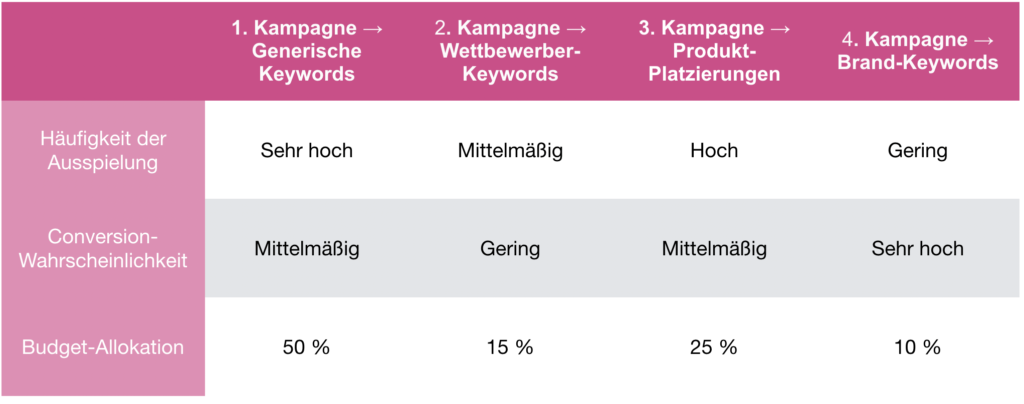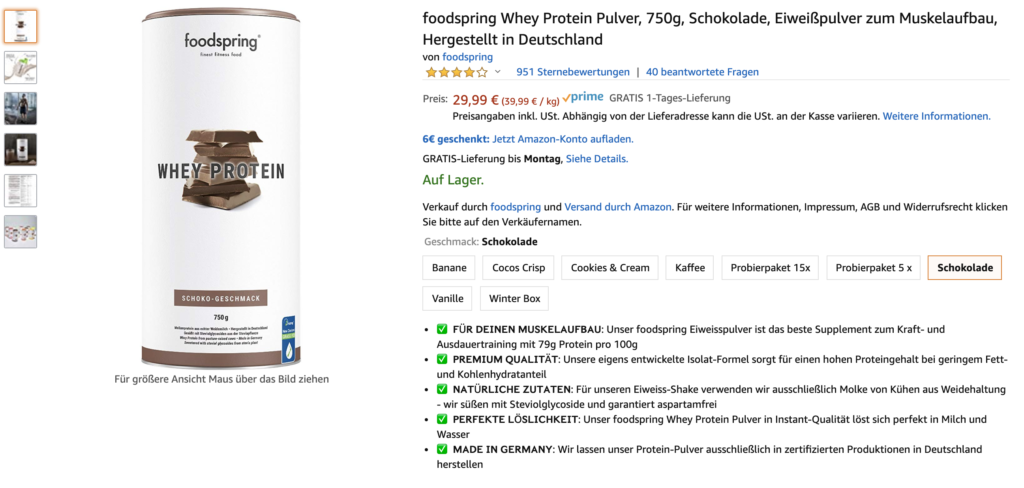In today's post, I'll be looking at the question of what different types of campaigns can be used for the placement of Advertisements on Amazon can be used. My suggestions and ideas are based on my practical experience gained from daily account management. The campaign types I suggest cannot be applied to every product or company and therefore always require a specific classification in the appropriate environment.
What are the different types of campaigns?
1. generic keyword campaign
By a generic search term campaign, I mean a manual sponsored product campaign that only contains generic search terms. Brand search terms, both your own brand and third-party brands, should not be entered here. However, I usually enter the own brand and third-party brands as a negative keyword ("phrase match"). I also create two ad groups for each homogeneous product group: one with the keyword targeting "Exact" and one with the targeting "Broad". The keywords within the ad groups are identical, so the exact keywords within the "broad" ad group are set to negative "exact" (more on this later in the practical section).
2. product alignment campaign
The second campaign type is a manual sponsored product campaign that contains the "product targeting" targeting type. This means that we do not define search terms to be displayed in the search results pages, but select specific products and/or product categories where the ads for the products to be advertised are displayed. I also like to work with two ad groups per product group to be advertised in a product targeting campaign. I call the first ad group "ASIN targeting". In this ad group, I research the ASINs of competitors on which the ads will be displayed. I call the second ad group "category targeting". Here I select suitable product categories in which the ads should appear. It is important that your own brand placements are set to negative in "category targeting" so that there are no "distorted" results.
3. competitor campaign based on search terms
In the third manual sponsored product campaign, I only display the ads for search terms that include competitors with their product names. Here, too, I usually work with two ad groups ("Broad" and "Exact").
4. brand campaign
Finally, the so-called "brand campaign" is used. In most cases, I create this both as a sponsored product campaign and as a sponsored brand campaign. Within the brand campaign, only the own brand search terms are defined as keywords and the own product detail pages as product orientation. The aim of the brand campaign is to ensure visibility in your own "territory".
What is the idea behind the campaign structure presented?
One problem that I regularly see when evaluating ad accounts is the lack of a campaign structure. The advantage of a clear campaign structure is that the performance of the advertising campaigns can be correctly assessed at a glance. By dividing the campaigns into brand campaign, competitor campaign, product targeting campaign and generic keyword campaign, a better assessment of the campaign performance is possible. It is also much quicker and easier to determine what the actual AcoS values are for each campaign type. As the AcoS value is very dependent on the respective campaign focus, it can be determined easily and quickly for everyone using the campaign structure presented here.
What are the characteristics of the different campaign types?
In the following graphic, the campaign types are evaluated according to the frequency of playout ("impression"), the conversion probability and a general budget allocation. These are also empirical values, which are of course not suitable for every product.

Campaign structure using an example
As I think it is easier to illustrate such a topic with a concrete example, I will explain the different types of Sponsored product campaigns for the following sample product:
foodspring Whey Protein Powder, 750g, chocolate, protein powder for muscle building, made in Germany

1. generic keyword campaign
In this example, we are promoting a chocolate-flavored whey protein, so the first step is to use the Amazon Brand Analytics function to identify relevant search terms.
In this step, it is important that we only identify generic search terms and ignore our own brand term and competitors. In addition to the obvious search term "whey protein", I also carry out this process for the following terms: "protein powder", "protein", "protein powder", "muscle building powder" etc.
Within the campaigns, we now have two ad groups ("Broad" and "Exact"), corresponding to the targeting types. It is important that we define negative keywords or keywords to be excluded at campaign level. In my example, I define the following terms as negative phrases: "Foodspring", "ESN", "Zec Plus", "Ironmax", "All Stars", etc.
2. product alignment campaign
Next, I create a manual product targeting campaign, which in this case contains two ad groups (more than two would be conceivable). Within the first ad group, we determine the products on whose product detail page the product to be advertised should be displayed. This is a manual process and can be simplified using the best seller rank of the respective category, in our example: https://www.amazon.de/gp/bestsellers/drugstore/5979638031/ref=pd_zg_hrsr_drugstore
As Foodspring is a brand in the higher price segment, in this example I only select products that have a minimum retail price of €20 per kilogram. I do not carry out any further segmentation according to taste and protein type in the first step.
In the second ad group, we now define product categories that are to be used for targeting. I refine the product categories so that only products with a sales price of more than €20 are considered. You can see the selected product categories below.
After defining the product categories, I exclude "foodspring" as a negative placement in the next step.
3. competitor campaign based on search terms
As we determined the relevant competitors in the first campaign (generic keyword campaign) using Amazon Brand Analytics, we can easily transfer the competitor keywords to a manual campaign with two ad groups ("Broad" and "Exact"). Here too, the exact match keywords are entered as negative exact keywords in the broad campaign. It is up to you whether you also want to book the individual brand terms of competitors as keywords (e.g. "All Stars"). In most cases, I leave these search terms out.
4. brand campaign
Within the brand campaign, I now define an ad group with a search term focus and insert the appropriate brand terms (e.g. "foodspring", "foodspring protein" etc.). I then add a second ad group with the appropriate product focus, which only shows the Foodspring brand as a placement. In this way, I ensure that only my own brand products are displayed when a brand search query is submitted.
In addition to the sponsored product campaign, a sponsored brand campaign is also recommended here, which is also geared towards your own brand search terms.
Conclusion on the campaign structure of advertising campaigns on Amazon
I use the campaign structure presented here for brand owners who sell their products via Amazon. In order for the campaign structure presented here to be useful, it is necessary for customers to actively search for their own and third-party brands. If there are no search queries for the brands, the structure can also be reduced to a generic search term campaign and product targeting campaign.
NoteDo you need support with campaign design & optimization on Amazon? Then we can help you as Amazon PPC Agency can help.

